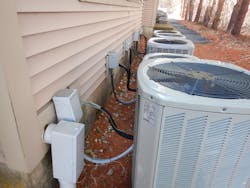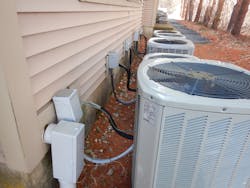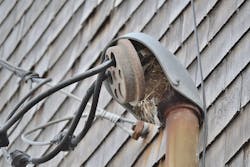All references are based on the 2023 edition of the NEC.
No Room for Error
Section 440.14 was revised in the 2023 NEC to address installations such as these. The disconnects for each one of these air conditioning units were installed directly behind the unit, leaving almost no room for service personnel to safely work on them. This is now an unquestionable violation of Sec. 440.14. The disconnecting means must meet the working space requirements of Sec. 110.26(A). This means there must be at least 3 ft of depth, 30 in. of width, and 6.5 ft of working space height in front of each disconnect to provide personnel some space to troubleshoot, examine, adjust, service, or otherwise maintain this equipment while it is energized. This revision is a great step in promoting a safer working environment. In previous editions of the Code, the requirements of Sec. 110.26(A) may not have always been applied uniformly to air conditioning disconnects. Some installers and inspectors were not requiring the Sec. 110.26(A) working space for disconnects that did not contain overcurrent devices such as fuses or circuit breakers. With the new wording in Sec. 440.14, the type of disconnect installed no longer matters. Hopefully, this revised wording will be easier for installers and inspectors to understand and apply.
Bird is the Word!
While there may not be any specific Code rules about preventing birds from nesting in a weatherhead, there are plenty of other applicable rules we could discuss. Section 230.54(A) requires service raceways to be equipped with a service head at the point of connection to overhead service conductors or service drop conductors. The service head (or weatherhead) must be listed for use in wet locations. With the insulator popped out of this weatherhead, rain and snow are much more likely to enter and run down the inside of this raceway and potentially cause damage to equipment connected to it. Section 230.54(C) requires the service head to be located above the point of attachment of the overhead service conductors or service-drop conductors. This service head is below the point of attachment, and the exception would not be applicable here, as there is no practical reason to have this raceway stop where it did. One other concern is the cracked insulation on the conductors where they exit the service head. Water can now seep into those cracks and flow underneath the conductor insulation as if it was a hose. This can lead to serious damage at the terminals where these conductors are connected. Section 310.10(D) requires insulated conductors exposed to sunlight to be listed as sunlight resistant or covered with a sleeve or tape that is sunlight resistant.
About the Author

Russ LeBlanc
Owner
Russ started in the electrical trade as an apprentice in 1985. He worked his way up to become a Journeyman Electrician and then eventually became a Master Electrician and Licensed Construction Supervisor. In 1999 Russ become an Electrical Instructor for The Peterson School of Engineering in Massachusetts where he developed his passion for teaching, and quickly became Department Head of Electrical Instruction. Russ has taught thousands of apprentices, electricians, engineers, inspectors, and other electrical professionals during his career as an instructor. He continues to provide electrical professionals with Electrical Code seminars, Arc-Flash Awareness training seminars and educational material through his LeBlanc Consulting Services in North Reading, MA whose specialty is educating electricians. He has been an active member of the NFPA Electrical Section and has authored hundreds of National Electrical Code proposals and comments which have become Code rules to improve the safety for the electrical industry. Russ is also an IAEI certified Electrical Inspector.
Please visit www.russleblanc.net for more information.


